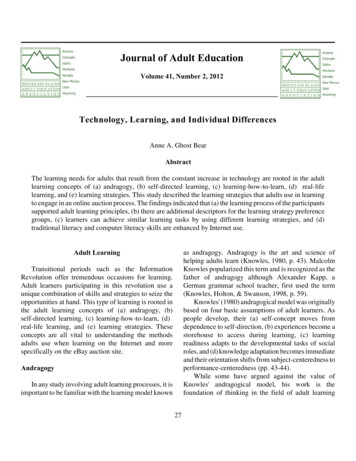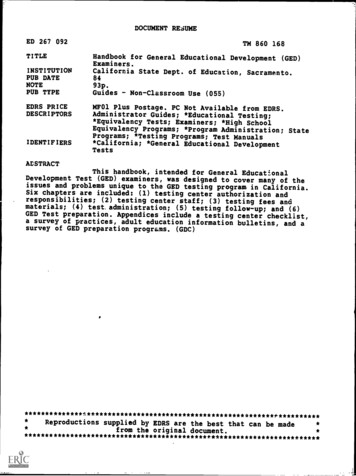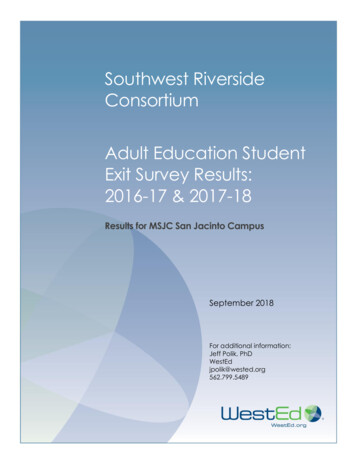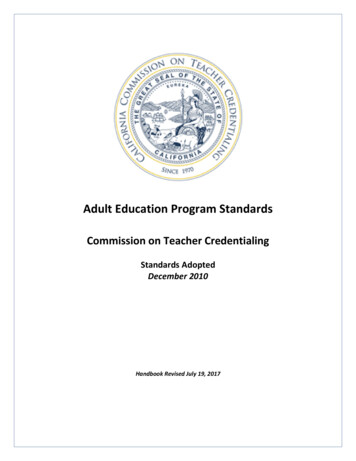
Transcription
Journal of Adult EducationVolume 41, Number 2, 2012Technology, Learning, and Individual DifferencesAnne A. Ghost BearAbstractThe learning needs for adults that result from the constant increase in technology are rooted in the adultlearning concepts of (a) andragogy, (b) self-directed learning, (c) learning-how-to-learn, (d) real-lifelearning, and (e) learning strategies. This study described the learning strategies that adults use in learningto engage in an online auction process. The findings indicated that (a) the learning process of the participantssupported adult learning principles, (b) there are additional descriptors for the learning strategy preferencegroups, (c) learners can achieve similar learning tasks by using different learning strategies, and (d)traditional literacy and computer literacy skills are enhanced by Internet use.as andragogy. Andragogy is the art and science ofhelping adults learn (Knowles, 1980, p. 43). MalcolmKnowles popularized this term and is recognized as thefather of andragogy although Alexander Kapp, aGerman grammar school teacher, first used the term(Knowles, Holton, & Swanson, 1998, p. 59).Knowles' (1980) andragogical model was originallybased on four basic assumptions of adult learners. Aspeople develop, their (a) self-concept moves fromdependence to self-direction, (b) experiences become astorehouse to access during learning, (c) learningreadiness adapts to the developmental tasks of socialroles, and (d) knowledge adaptation becomes immediateand their orientation shifts from subject-centeredness toperformance-centeredness (pp. 43-44).While some have argued against the value ofKnowles' andragogical model, his work is thefoundation of thinking in the field of adult learningAdult LearningTransitional periods such as the InformationRevolution offer tremendous occasions for learning.Adult learners participating in this revolution use aunique combination of skills and strategies to seize theopportunities at hand. This type of learning is rooted inthe adult learning concepts of (a) andragogy, (b)self-directed learning, (c) learning-how-to-learn, (d)real-life learning, and (e) learning strategies. Theseconcepts are all vital to understanding the methodsadults use when learning on the Internet and morespecifically on the eBay auction site.AndragogyIn any study involving adult learning processes, it isimportant to be familiar with the learning model known27
during the last decade (Hiemstra & Sisco, 1990;Merriam, 2001). Andragogy is “a term that ‘belongs’ toadult education” (Merriam & Brockett, 1996, p. 135).computer mouse while others are very complex such aslearning to design and assemble an heirloom quilt or astained glass window. These events may involve one ormore participants and may occur in formal or informalsettings. Research related to self-directed learningreveals that 90% of adults conduct at least oneself-directed learning project annually (Tough, 1978)and that 70% of adult learning is self-directed in nature(Tough, 1978).Knowles describes two concepts of self-directedlearning (Brookfield, 1986; Candy, 1991). First,self-directed learning is self-teaching in which learnershave power over all mechanical aspects and approachesof their learning processes. Secondly, self-directedlearning is personal autonomy or “taking control of thegoals and purposes of learning and assuming ownershipof learning” (Knowles, 1998, p. 135).An attempt to categorize self-directed learningworks to restrict its broad meaning. Simply stated, selfdirected learning is any process where the learner is thedecision-maker and in control of the learning process.Indeed, self-directed learning is a freedom that alllearners should be permitted to explore (Rogers, 1969)."It is self-initiated. Even when the impetus or stimuluscomes from the outside, the sense of discovery, ofreaching out, of grasping and comprehending, comesfrom within" (p. 5).Self-Directed LearningJust as society is experiencing this eruption indissemination of information through the Internet, adulteducation too is changing with the rapid expansion ofresearch in the area of self-directed learning. Whileunidentified for centuries, self-directed learning hasonly become formally recognized and studied during thelast several decades (Knowles, 1990). The field of AdultEducation and adult educators have becomeincreasingly interested in self-directed learning since the1970s (Long, 1992). Self-directed learning is a processfrequently associated with the field of Adult Education.The process occurs when:Learning-How-to-LearnQuite often, adult learners come into a learningsituation with the key to a powerful process. Thatprocess is known as learning-how-to-learn. Learninghow-to-learn may mean different things for differentpeople. In the last three decades, the seminal researchon learning-how-to-learn was compiled by Robert M.Smith. He developed a theory and repertoire of trainingexercises founded on the idea that it is “as important toteach adults how to learn as it is to specify particularcurricular domains for learning” (Brookfield, 1986, p.64). In his initial work, Smith (1976) offers a workingdefinition of learning-how-to-learn as “a matter of theadult's having (or acquiring) the knowledge and skillIndividuals take the initiative, with or withoutthe help of others, in diagnosing their learningneeds, formulating learning goals, identifyinghuman and material resources for learning,choosing and implementing appropriate learningstrategies, and evaluating learning outcomes.(Knowles, 1975, p. 18)The concept of self-directed learning applies tomany learning events in the Information Age. Somemay be quite simple such as learning to operate a28
essential to function effectively in the various learningsituations in which he finds himself” (p. 5). In laterwork, Smith (1982) defined learning-how-to-learn as“possessing, or acquiring, the knowledge and skill tolearn effectively in whatever learning situation oneencounters” (p. 19).Though defining is a challenge, understanding theconcept of learning-how-to-learn is important to thefield of Adult Education for it “holds great promise forhelping adults expand their learning effectiveness”(Knowles et al., 1998, p. 166). Thus, understanding theconcept of learning-how-to-learn is more important thanestablishing a definition. Learning-how-to-learn happens in everyday lives, yet little research aboutlearning-how-to-learn outside of formal educational ororganizational settings exists.Smith had prophetic words to offer related tolearning-how-to-learn that applies to today almost threedecades later. “In an era of breathtaking change, it istruly impossible to acquire early in life the knowledgethat adulthood will require” (p. 15). Therefore, sincelearning itself can be learned and taught through use ofvarious processes, perceptions, and capacities, “one canlearn how to learn more effectively and efficiently” (p.15). “It is a tragic fact that most of us only know how tobe taught; we haven’t learned how to learn” (Knowles,1975, p. 14).Adult education is a process (Smith, 1976, p. 6). Itis important to involve the learner in every phase of theprocess. Critical to this process is the development ofeach learners' awareness and capacity for effectiveself-monitoring and active reflection (Smith, 1991, p.11). Involving the learner in this process includesparticipation in planning, conducting, and evaluatinglearning activities (Smith, 1976, p. 6). These subprocesses assume that the learner is involved to thegreatest extent possible and that “the learner needs thiskind of knowledge and skill to function optimally in thethree phases of the process” (p. 6).The first subprocess of adult learning is Planning. Itestablishes how adult learners identify their needs andset goals as they select resources and strategies. Thesecond subprocess is Conducting. This is the adultlearners' learning activity where they negotiate selectedprocedures and resources as they learn to give andreceive feedback. Finally, the third subprocess isEvaluating. This is how well adult learners measure theextent to which and how efficiently their goals are met.Learners must be equipped with these subprocesses toobtain the knowledge and skills to proceed withfollow-up activities. Adult learners must possess andpractice these skills through the learning-how-to-learnprocess. Moreover, facilitators of adult learning eventswill serve the teaching-learning exchange moreeffectively if they realize the power of this learninghow-to-learn process.Real-Life LearningLearning from everyday situations, opportunities,dilemmas and experiences is a process all learnersconfront countless times during their lives. As a field ofstudy, Adult Education examines the benefits oflearning that is immediately applicable to adult learners'lives as opposed to learning that is from ateacher-directed curricula in formal education. Real-lifelearning is "relevant to the living tasks of the individualin contrast to those tasks considered more appropriate toformal education" (Fellenz & Conti, 1989, p. 3).Learning processes traditionally used in formaleducational settings differ dramatically from theprocedures of real-life learning. With real-life learning,more attention is given to the living tasks of individuallearners rather than tasks proposed by formal education(Fellenz & Conti, 1989). People are generally illprepared through formal education to learn fromeveryday life experience (Sternburg, 1990, p. 35).Learning StrategiesLearners have individual differences in how theyconduct learning activities. Those differences have beenreferred to as learning styles and learning strategies.Learning styles are the stable traits with which learnersare born and on which they rely when involved in alearning situation (Fellenz & Conti, 1989, p. 8). A29
and located on the researcher's website. Thisquestionnaire consisted of open-ended questions andquestions with identified choices. It gave respondents anopportunity to describe how they: (a) learned abouteBay and navigated the site, (b) formed and exercisedtheir bidding strategies, (c) communicated with otherpeople on eBay, and (d) felt about the skills theylearned. Within the online questionnaire, 19 qualitativerequests in an open-ended format were presented alongwith 5 quantitative requests which featured 5-pointLikert scale choices. In addition to these questions,demographic data on each participant was requestedrelated to education, gender, age, and race. Finally, theAssessing The Learning Strategies of AdultS (ATLAS)instrument was imbedded within the questionnaire todetermine the preferred strategies of eBay users.ATLAS is a valid and reliable instrument designedto quickly identify learning strategy preferences (Conti,2009). For this study, the ATLAS instrument wasimbedded in the online questionnaire rather that beingused in its original booklet format (Conti, 2009, p. 889).Participants followed descriptive phrases by clickingtheir mouse indicators on selected responses. Eachresponse led the participants to eventually discover theirlearning strategy group of Navigator, Problem Solver,or Engager.person's learning style is "the individual's characteristicways of processing information, feeling, and behavingin certain learning situations" (Smith, 1982, p. 24).Learning style is one of the three components of thelearning-how-to-learn process (Smith, 1982, p. 23).Learning styles are generally established in childhoodand are steady throughout the learner's life (Fellenz &Conti, 1989, p. 8).In contrast to learning styles are the strategies thatlearners use when initiating a learning activity. Learningstrategies are "the techniques or skills that an individualelects to use in order to accomplish a learning task"(Fellenz & Conti, 1989, p. 7). Learning strategies mayalso describe ways in which learners and their resourcesmay be arranged during learning situations (Smith,1982, p. 113). Learning styles are influenced by intrinsicways of information processing whereas learningstrategies deal with the methods learners use to gaininformation in different learning situations (Conti &Kolody, 1995). Rather than being an intrinsic process,learners have more control over learning strategies thanthey do over learning styles. Learning strategies arebehaviors that the learner may choose when attemptinga learning task (Fellenz & Conti, 1989).MethodologyThe purpose of this study was to describe thelearning strategies that adults use in learning to engagein an online auction process. This study used adescriptive design along with the information and datagathering advantages of the Internet to collect dataabout how adults learning using the Internet. The studyinvolved a representative sample of 380 eBay userswhich was identified by the e-mail addresses ofparticipants in completed auctions.QuestionnaireThis study investigated the Internet learning on eBayand described the learning strategies adults use whileengaged in the eBay auction process. Data weregathered by means of a questionnaire that was created30
rely on the critical thinking skills of testing assumptionsto evaluate the specifics and generalizability within alearning situation, generating alternatives to createadditional learning options, and embracing conditionalacceptance of learning outcomes while keeping an openmind to other learning possibilities (p. 894). Anotherstudy which described the ways learners utilized selfdirected learning on the Internet (Spencer, 2000) foundsimilar results in that 50.66% of the participants wereidentified as Problem Solvers.ParticipantsThe profile of the respondents supports the generalstereotypes of a digital divide; the digital divide “is thegap between people with access to computers and theInternet and those without it” (Ghost Bear & Conti,2002, p. 231). Of the 380 participants in the study, thegender distribution of the sample was nearly equal with188 males (50.1%) and 187 females (49.9%); only 5participants did not report their gender. The group wasfairly well educated; the highest educational level ofnearly one-fourth (23%) was a high school diploma, ofone-fifth (20%) was a post-secondary degree orcertificate, of nearly one-third (30.5%) was a bachelor’sdegree, an of one-fourth (25.1%) was a graduate degree.Only five (1.4%) had less than a high school diploma,and these respondents were young enough to still be inschool. The respondents ranged in age from 13 to 70with a mean of 41.08 and a median of 43. Responseswere received from 8 countries in addition to the UnitedStates; these 15 responses came from Australia (2),Canada (6), Germany (2), Denmark (1), Finland (1),Mexico (1), Russia (1), and United Kingdom (1).Although eBay has an international membership, therespondents were overwhelmingly White (93.3%); nonWhite ethnic origins were as follows: African--.3%,Asian--1.0%, Hispanic--1.7%, Native American--1.0%,and Other--2.7%. Also, the responses were mostly fromsites that indicated that private individuals participatedin the study.Although the three learning preference groupsidentified by ATLAS exist in nearly equal portions inthe general adult population, a disproportionately largenumber of Problem Solvers use eBay ( 2 30.3, df 2,p .001). The distribution on ATLAS in the generalpopulation, which was the expected distribution for thisstudy, is as follows: Navigators--36.5%, ProblemSolvers--31.7%, and Engagers--31.8% (Conti, 2009, p.891). However, the observed distribution in this studywas as follows: Problem Solvers--45.2%, Navigators-28.5%, and Engagers--26.3%. Thus, there are a greaternumber of Problem Solvers using eBay than the otherlearning strategy preference groups. Problem SolversFindingsThe findings from the study provide support forconclusions in four areas. First, the process in which theparticipants engaged in order to learn about the onlineauction process provides support for adult learningprinciples. Second, the language and process used bythe participants provide additional descriptors for thethree learning strategy preference groups identified byATLAS. Third, the findings revealed that the process ofachieving similar learning tasks could be successfullyaccomplished by using different learning strategies.Fourth, the findings showed how the traditional literacyand computer literacy skills of Internet users areenhanced by Internet use.Adult Learning PrinciplesAndragogical ConceptsInformal learning on eBay exemplifies the sixassumptions upon which Knowles’ andragogical modelis based. A tremendous amount of informal learning hastaken place in order for the eBay users to engage in thevarious parts of the eBay auction process. As thefindings from this study clearly disclose, participation ineBay activities personifies adult learning at its best andillustrates the andragogical assumptions written decadesago. Although Malcolm Knowles developed the fourcore assumptions of andragogy over 40 years ago(Knowles, 1970), his assumptions apply to the currentInformation Age with amazing relevance. His31
assumptions are so applicable, it is as if they werewritten to describe the very learning processes thatadults use today when engaging in eBay auctionactivities. Likewise, the two additional assumptions thatwere added in 1984 and 1989 (Knowles et al., 1998, p.69) also readily apply and give foundation to the learning phenomenon characterized by eBay participation.The core principles of andragogy “go beyond basicrespect for the learner and view the adult learner as aprimary source of data for making sound decisionsregarding the learning process” (p. 183).Knowles’ first assumption in the andragogicalmodel has to do with adults learners’ need to know(Knowles et al., 1998, pp. 64-65). Adults need to knowwhy they are learning before they participate in alearning activity (p. 133). Adult learners who participateon eBay may go about learning for different reasonssuch as to explore the eBay website or to purchase aspecific item. However, they all know why they haveelected to participate in the online auction activities.The second assumption in the andragogical modelinvolves self-concept (Knowles et al., 1998, p. 65). Theself-concept of adult learners as they move fromdependency to self-direction leads to the knowledge thatthey are “responsible for their own decisions, for theirown lives” (p. 65). Adult participants in the eBayauction process are self-directed in nature. They havedetermined their interests, goals, and individual coursesof inquiry. In addition, they determine their degree andlevel of participation each time they join the eBayactivities.The third assumption has to do with the role of theadult learners’ experiences (Knowles et al., 1998, pp.65-67). As they take part in eBay operations, the adultlearners bring a variety of experiences to their action.Each adult learner who chooses to participate in eBayactivities brings a lifetime of experiences to the onlineauction. Some may have many experiences with liveauctions while others may have extensive knowledge ofparticular collectibles and while still others may haveprior computer skills or human relationship skills.Nevertheless, they all have a foundation from which todraw that enhances their learning on eBay. This eBayparticipant exhibits Knowles’ third assumption ofandragogy as she developed her bidding strategy:I learned that bidding early in the auction isusually a waste of time. When people see bidson items, they are more inclined to check it outand bid themselves. Also, some people alwayslike to be top dog, so it just drives the price up.I also learned to check out the bidding lists ofpeople who liked the same things I did. I figuredif I do it, they may too--so that's why I don't tendto bid on things until the end. I also learned thatmany people DON'T bid their maximum--theybid what they think is "enough" then race toplace another bid if outbid near the end. That'swhy I snipe--to not give them a chance to placeanother bid and drive the price up. (39-year-oldfemale Problem Solver)The fourth andragogical assumption pertains toadult learners’ readiness to learn. Readiness to learn isconnected to each learners’ particular developmentalstage in life. Adult learners reject anything that isirrelevant to their current learning situations. Despitetheir various reasons for engaging in eBay, these adultlearners find great relevance in eBay’s ability to meettheir needs and goals. The decisions they make whileparticipating in all steps of eBay all have great relevanceto the learners.The final two assumptions of the andragogicalmodel relate to adults’ orientation to learning andmotivation. Adults learn more effectively “when theyare presented in the context of application to real-lifesituations” (Knowles et al., 1998, p. 67). The orientationof adult learners is life-centered, task-centered, orproblem-centered (p. 67) rather than the typical subjectcentered curriculum of children’s learning. Learning oneBay is organized around the participants’ particular lifesituations. For example, this eBay user was looking fora particular item and her quest lead her to eBay:I punched into my favorite collectibles andstarted looking at the various dogs. Then I32
techniques such as “specifying goals” as they determinetheir auction objectives, “identifying resources” thatwill assist their auction decisions, “implementingstrategies” that will best suit their bidding needs, and“evaluating progress” of their auction-related intentions.Adult learners who participate in eBay’s onlineauction process are also practicing Brookfield’s secondidentified form of self-directed learning, which isinternal consciousness change (Brookfield, 1986, p. 47).The adults who involved themselves in the eBay auctionprocess had a variety of complex internal shifts on avariety of developmental levels. These changes inawareness not only were recognized by the studyparticipants, they were also reviewed and reported bythem.learned how to punch in Scotties under searchand come up with only those specific items. (52year-old female Problem Solver)Finally, internal motivators such as satisfaction and selfconfidence inspire adult learners to new levels ofgrowth and development (p. 68). Thus, the intrinsicrewards of participating in the eBay auction processfeeds the natural desires of adult learners as they gainnew skills, acquire new items, make new friends, andconfirm their beliefs all in a setting that is free oftraditional educational barriers. Instances of adultlearners who responded to internal motivators wererepeatedly found during this study. For example:I never really thought about it before, but themore I learn, the better I feel about myself. It'sfun to share the knowledge with others. (42year-old female Engager)I feel much better about computers and theInternet since I am able to communicate withpeople who have similar interests. At first I wasnervous about bidding on Internet auctions, butafter gaining experience over time I find it veryexciting and convenient. (23-year-old maleEngager)Self-Directed LearningAdult learners who engage in the eBay auctionprocess are exhibiting self-directed learning. Theknowledge that adults engage in self-directed learningis now a “foregone conclusion in adult learningresearch” (Knowles et al., 1998, p. 135). Along withothers, Stephen Brookfield (1986) and MalcolmKnowles (1975) made important contributions to thebetter understanding of self-direction in adult learning.Brookfield identified two forms of self-direction, andKnowles brought forth five assumptions of self-directedlearning. Adults who partake in the eBay auctionexemplify the work on self-direction of both these mento light in a new era that perhaps even they neverenvisioned.The first of Brookfield’s (1986) two forms of selfdirection is that there are “various techniques of selfdirected learning” (p. 47). As adult learners participatein the many procedures entailed in an online auction,they are practicing many of Brookfield’s identifiedtechniques. The findings produced many examples ofeBay users participating in such complex self-directedBuilt my confidence in the Internet becominguser-friendly for me. I have become morecomputer-literate. I have learned, because ofeBay use, how to use a scanner, how to videocapture, how to resize pictures & reduce filesize, upload pictures to a website for ourauctions, how to use the Internet to find thingsthat greatly enrich our home, personal studies &research, family needs, etc. as well as provide asupplemental income for our family. (35-yearold female Problem Solver)Just as they parallel his andragogical assumptions,Knowles’ (1975) five assumptions of self-directedlearners also correspond nicely with the actions of theadult learners who participated in this study. As an“essential component of maturing” (p. 20), the studyparticipants have grown naturally into the need to beself-directed as they enter and proceed through the33
eBay users identified their needs for a particular auctionitem or they identified their needs for a different biddingstrategy.auction activities. These adult learners have alsoexhibited how important their pre- and post experiences(p. 20) related to eBay are to their learning and that theirlearning needs change in correlation to theirdevelopmental levels (p. 20) as they progress throughthe processes associated with eBay. In addition, theadult learners who have engaged in the eBay auctionprocess have accomplished tasks and solved problems(p. 21) as they registered on eBay, learned about thesite, researched items and other users, developedbidding strategies, and undertook a host of other tasks.Lastly, the internal incentives of eBay users haveinspired them to new levels of achievement,satisfaction, and accomplishment (p. 21) as they joinedin the website’s activities.It only took a couple of auctions to realize thatif I bid early and high the other bids would driveup my price. I also found that small frequentbids developed a competition which is what theseller wants but not the buyer. (51-year-old maleNavigator)Conducting was demonstrated when the eBayparticipants reviewed their bidding procedures orutilized available resources. For example,It was an evolution from simply bidding andwaiting to sniping (if the item is particularlyinteresting). I learned this behavior from thenumerous times when another bidder did it tome. (29-year-old male Engager)Learning-How-to-LearnAdult learners have implemented the theory oflearning-how-to-learn through participation in the eBayauction process. Not only do adult learners who haveparticipated in eBay’s auction activities exemplify theandragogical model and the concepts of self-direction,they also have implemented the theory introduced bySmith (1982) called learning-how-to-learn. Along withKnowles (1970), Smith had prophetic words to offerrelated to learning-how-to-learn that applies to theInformation Age decades later. “In an era ofbreathtaking change, it is truly impossible to acquireearly in life the knowledge that adulthood will require”(p. 15). Therefore, since learning itself can be learnedand taught through use of various processes,perceptions, and capacities, “one can learn how to learnmore effectively and efficiently” (p. 15). “It is a tragicfact that most of us only know how to be taught; wehaven’t learned how to learn” (Knowles, 1975, p. 14).Overcoming that tragedy are the adult learners of eBaywho have effectively learned how to learn.The adult learners who have participated in eBayauctions clearly practiced the three learning-how-tolearn subprocesses of planning, conducting, andevaluating (Smith, 1976, p. 6) in the informal setting ofeBay. An example of planning occurred when adultI read through each auction available on thespecific item. Some auctions offered links toother sites providing more info. I also did asearch and found retailers selling the item tocompare prices. (44-year-old female ProblemSolver)Examples of the adult learners on eBay who utilizedthe learning-how-to-learn subprocess of Evaluatingwere found in the many responses from eBay users whomet their auction goals in a variety of ways.My most costly purchase was an old applelaptop. I was nervous because it was electronic.The seller was not the original owner. He wastrying to "turn a buck". I was happy that themachine has worked thus far. It wascosmetically worse than I imagined, but I ampleased. I have purchased a motorcycle helmet,leather jacket, Gameboy case, and have beenpleased with everything. (43-year-old maleEngager)34
desirable and the seller has good feedback. (34year-old male Problem Solver)In addition to the applying the subprocesses oflearning-how-to-learn, the study participants have alsoperformed the less basic learning-how-to-learn skillswhich are all characteristics of the learner who hassuccessfully learned how to learn. These includedeciding what and where to learn, enhancing necessaryskills, being open to change, selecting the mode oflearning, and applying flexibility which are allcharacteristics of the learner who has successfullylearned how to learn. These higher-level skills arereferred to as the characteristics of successful learners(Smith, 1982, pp. 84-93).The adult learners who are eBay participantsdemonstrated these characteristics of successfullearners. Adult learners who have engaged in the eBayauction process have certainly decided to learn duringthat process and they decided what to learn based ontheir skills, goals, and needs. Many adult learners oneBay reported in the findings that they found itnecessary to access additional skills in order toparticipate in the auction processes. For example, as thisparticipant expressed:Real-Life LearningReal-life learning occurs when adult learners engagein the eBay auction process. Any reflection of adultlearning trends should include “learning that is relevantto the living tasks of the individual” (Fellenz & Conti,1989, p. 3). O
Journal of Adult Education Volume 41, Number 2, 2012 Technology, Learning, and Individual Differences Anne A. Ghost Bear Abstract The learning needs for adults that result from the constant increase in technology are rooted in the adult learning concepts of (a) andragogy, (b) self-directed learning, (c) learning-how-to-learn, (d) real-life










